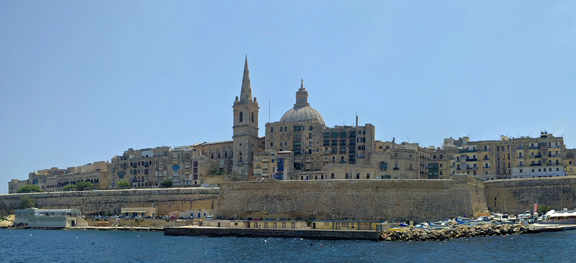 On a rocky island in the middle of the Mediterranean, less than an hour by boat south of Sicily, the warrior-monk Knights of St. John, spiritual and possibly actual heirs of the Templars, built their city state in the early 1500’s creating the nation of Malta. The Knights were defeated by the Ottoman Turks under Sultan Suleiman at Rhodes, and after some years of homelessness, Emperor Charles V deeded the island in 1520 to the Maltese Knights on which to create their new home base.
On a rocky island in the middle of the Mediterranean, less than an hour by boat south of Sicily, the warrior-monk Knights of St. John, spiritual and possibly actual heirs of the Templars, built their city state in the early 1500’s creating the nation of Malta. The Knights were defeated by the Ottoman Turks under Sultan Suleiman at Rhodes, and after some years of homelessness, Emperor Charles V deeded the island in 1520 to the Maltese Knights on which to create their new home base.
There they initially built the high walled fortress town of Mdina, on a view hill in the middle of the island, not far from the western Cliffs of Dingli. In the mid 1500’s, in order to better prepare to defend against raiding Turks and others, the Knights built the star-shaped fortress of St. Elmo and the adjoining walled city of Valletta out of limestone quarried locally on a ridged thumb of land jutting into two imposing sea harbors.
Home to 6,000 residents, Malta is a gridded pattern of a few dozen streets running along and perpendicular to the ridge-top of the thumb of land Those streets fall from the spine of Triq Ir-Republikka (Triq is Maltese for street) steeply down to the water on all three sides. The western end of town, or the base of the thumb, is guarded by massive stone walls, the city gate and a deep moat.
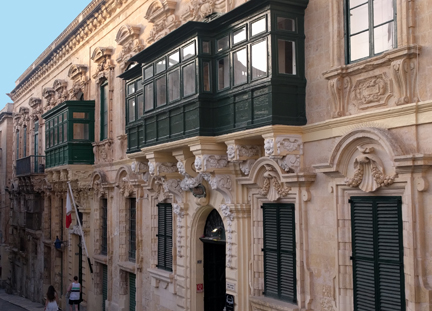 The closely clustered three and four-story houses that populate the town are built of stone, ornately decorated mostly in the Spanish Baroque style, with intricately twisting curlicues of stonework and protruding wooden glazed balconies in red, green and blue, reminiscent of the style found in certain Spanish towns such as Valencia.
The closely clustered three and four-story houses that populate the town are built of stone, ornately decorated mostly in the Spanish Baroque style, with intricately twisting curlicues of stonework and protruding wooden glazed balconies in red, green and blue, reminiscent of the style found in certain Spanish towns such as Valencia.
Our home for a week’s stay on the 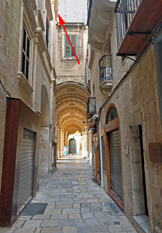 island is the double-terrace penthouse suite of the U Collection, a nascent lodging group created by Sylvana and her lawyer son Umberto Borg Cardona, who own two children’s clothing shops across the alley, Triq It-Tezorerija, and probably several other buildings in the area. They decided to convert the 17th century palazzo into four units, each its own level accessed directly by private elevator with key for each floor. They spent quite a lot of money on restoration, build-out, design, utilities, kitchens and bathrooms.
island is the double-terrace penthouse suite of the U Collection, a nascent lodging group created by Sylvana and her lawyer son Umberto Borg Cardona, who own two children’s clothing shops across the alley, Triq It-Tezorerija, and probably several other buildings in the area. They decided to convert the 17th century palazzo into four units, each its own level accessed directly by private elevator with key for each floor. They spent quite a lot of money on restoration, build-out, design, utilities, kitchens and bathrooms. 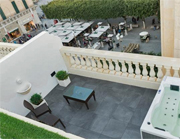 They couldn’t magic up additional space in the narrow building, and hence what’s billed as a suite is actually a studio, with no separate bedroom. But with both a main and rooftop terrace overlooking the central square Misrah Ir-Republikka, right in the center of town, it’s a good home base despite small size.
They couldn’t magic up additional space in the narrow building, and hence what’s billed as a suite is actually a studio, with no separate bedroom. But with both a main and rooftop terrace overlooking the central square Misrah Ir-Republikka, right in the center of town, it’s a good home base despite small size.
Malta is a highly visited place—for 2018 the European Culture Capital—where cruise ships regularly call, and though it’s not yet what Umberto assures us is the absolute craziness of August, there are plenty of sunburnt shorts-and-tee-shirt foreigners exploring the streets, alleys and nooks and crannies. There are curiously very few American accents to be heard....lots of English, Italians and Germans, as well as Eastern Europeans.
After settling our gear, we head downstairs to Eddie’s cafe, whose forest of green umbrellas our terrace overlooks, for a cool drink and an hour of watching the crowds wander by on the main street, Republikka. The very center blocks of Malta are pedestrian only, save for morning delivery trucks, so our cafe sitting is free of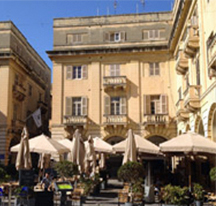 traffic noise. We move a block to St. John's Square and Restaurant San Giovanni for our first dinner. There are a few Maltese specialties, the most ubiquitous of which is rabbit: grilled, stewed, fried—otherwise menus are vaguely continental, with a good representation of local fish, as you’d hope. We share a couple of rounds of fried local goat cheese, followed by a huge order of linguine in rabbit sauce with local peas, which also seem to be ubiquitous on menus. Maltese wines have become increasingly sophisticated and high quality in recent years, and there are several to choose from. An Isis Chardonnay (the god, not the terrorists) is adequate, and a Syrah/Merlot blend from Meridiana is actually quite good.
traffic noise. We move a block to St. John's Square and Restaurant San Giovanni for our first dinner. There are a few Maltese specialties, the most ubiquitous of which is rabbit: grilled, stewed, fried—otherwise menus are vaguely continental, with a good representation of local fish, as you’d hope. We share a couple of rounds of fried local goat cheese, followed by a huge order of linguine in rabbit sauce with local peas, which also seem to be ubiquitous on menus. Maltese wines have become increasingly sophisticated and high quality in recent years, and there are several to choose from. An Isis Chardonnay (the god, not the terrorists) is adequate, and a Syrah/Merlot blend from Meridiana is actually quite good.
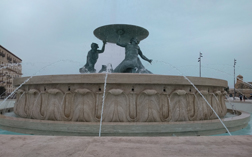 Our usual trick for orientation to a new place is to board the open top hop-on busses that run around most destinations...seems a bit hokey but is actually a great way to get to know the general lay of the land. The red bus winds from the Triton Fountain just outside the main city gate, past lower Valletta wharf-side, around Grand Harbor and through the triple fortified cities of Birgu, Senglea and Cospicua, then out through the countryside of
Our usual trick for orientation to a new place is to board the open top hop-on busses that run around most destinations...seems a bit hokey but is actually a great way to get to know the general lay of the land. The red bus winds from the Triton Fountain just outside the main city gate, past lower Valletta wharf-side, around Grand Harbor and through the triple fortified cities of Birgu, Senglea and Cospicua, then out through the countryside of 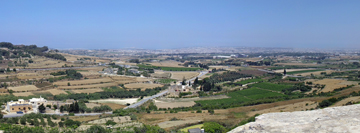 packed, flat-roofed square one-and-two story stucco houses. The chaotic residential jumble is very Arabic in feeling, and reminiscent of our trip to Aman, Jordan. The conveyance descends to the lovely fishing village of Marsaxlokk, where there is a Sunday fish market, then winds through the countryside and down the cliffs ringing Weid Babu, at the mouth of which sits the famous Blue Grotto, and on to a brief stop at the prehistoric Ħaġar Qim Temples, which date to 3200 BC. From there we meander north across the spine of the island, through small vineyards and
packed, flat-roofed square one-and-two story stucco houses. The chaotic residential jumble is very Arabic in feeling, and reminiscent of our trip to Aman, Jordan. The conveyance descends to the lovely fishing village of Marsaxlokk, where there is a Sunday fish market, then winds through the countryside and down the cliffs ringing Weid Babu, at the mouth of which sits the famous Blue Grotto, and on to a brief stop at the prehistoric Ħaġar Qim Temples, which date to 3200 BC. From there we meander north across the spine of the island, through small vineyards and 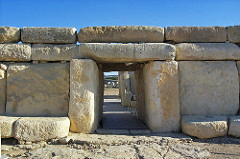 vaguely desolate farm plots. The island consists of undulating countryside, with rocky outcrops, copses of woodlands, some vineyards and agricultural fields with low stone walls and villages which in many places merge into each other. As noted, the jumbled blockish houses of dusty white and ochre seem very middle eastern in feeling. Soon we arrive at the north shore and St. George’s Bay and St Julien’s bay, where all the resort hotels and beach action are centered. Paranga, the St. George Bay beachside restaurant of t
vaguely desolate farm plots. The island consists of undulating countryside, with rocky outcrops, copses of woodlands, some vineyards and agricultural fields with low stone walls and villages which in many places merge into each other. As noted, the jumbled blockish houses of dusty white and ochre seem very middle eastern in feeling. Soon we arrive at the north shore and St. George’s Bay and St Julien’s bay, where all the resort hotels and beach action are centered. Paranga, the St. George Bay beachside restaurant of t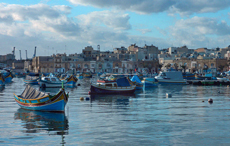 he Intercontinental Hotel is a great stop for a fresh fish and seafood lunch. We have cold prawns to start and then seafood frito misto which brings perfectly crunchy calamari, shrimp, prawns and seabream chunks.
he Intercontinental Hotel is a great stop for a fresh fish and seafood lunch. We have cold prawns to start and then seafood frito misto which brings perfectly crunchy calamari, shrimp, prawns and seabream chunks.
In the afternoon we continue orientation with a two-hour harbor tour 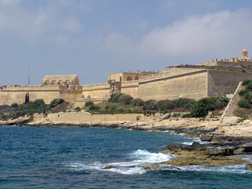 that begins across Marsamxett harbor to the north of Valletta (€.9 ferry to cross to Sliema) then winds through that harbor, past Fort Manoel, out around St. Elmo Fort and through Grand Harbor and its various creek inlets and the finger-harbors of the three cities of Senglea, Cospicua and Vittoriosa, and finally past Fort St. Angelo and around the Ricasoli Fortification. Recorded commentary tells of Valletta’s founding, the harbors’ history, the failed Ottoman siege of 1565, the enormous bombing damage in WWII, and the importance of the extensive shipyards—which really are impressive.
that begins across Marsamxett harbor to the north of Valletta (€.9 ferry to cross to Sliema) then winds through that harbor, past Fort Manoel, out around St. Elmo Fort and through Grand Harbor and its various creek inlets and the finger-harbors of the three cities of Senglea, Cospicua and Vittoriosa, and finally past Fort St. Angelo and around the Ricasoli Fortification. Recorded commentary tells of Valletta’s founding, the harbors’ history, the failed Ottoman siege of 1565, the enormous bombing damage in WWII, and the importance of the extensive shipyards—which really are impressive.
Valletta from the water presents an imposing and majestic vista—the founding Knights of St John were intent on building a capital city on par with anything in Europe. You don’t even 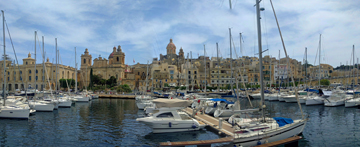 have to squint to imagine the dark-masted ships of the Iron Islands sailing into King’s Landing… and in fact, early segments of Game of Thrones were filmed in the harbor. Returning from the harbor tour by the Sliema Ferry, we proceed to the next leg of orientation, and for €5 each, board an 8-seat electric cart for a half-hour guided tour of the streets and byways of Valletta, highlighting the sites we’ll explore in coming days: the Grandmaster’s Palace, St John’s Cathedral, Manoel Theater, Triton Fountain and City Gate, Barrakka Gardens and St Paul’s.
have to squint to imagine the dark-masted ships of the Iron Islands sailing into King’s Landing… and in fact, early segments of Game of Thrones were filmed in the harbor. Returning from the harbor tour by the Sliema Ferry, we proceed to the next leg of orientation, and for €5 each, board an 8-seat electric cart for a half-hour guided tour of the streets and byways of Valletta, highlighting the sites we’ll explore in coming days: the Grandmaster’s Palace, St John’s Cathedral, Manoel Theater, Triton Fountain and City Gate, Barrakka Gardens and St Paul’s.
In the early evening we head out Republikka through the city gate to the baroque 5-star Hotel Phoenicia for a site inspection and then a leilsurely cocktail on the elegant terrace overlooking a lovely garden and a vista of Marsamxett Harbor.
The following morning we provision the apartment variously from the central market hall Is-Suq Tal-Belt and a fascinating shop called Allison stores, both in Triq Il-Merkanti, or Merchant's Street. Allison Stores is little different than it must have been during the period of British rule and carries a fascinating combination of local spices and foods, British staples (Bovril, Coleman's mustard, Carr’s biscuits, lemon squash), hardware, tools, cooking utensils, and the Maltese flatbread Ftira. Is-Suq Tal-Belt, just opened in January, was converted from the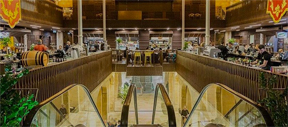 old central market, and is housed in a soaring Victorian-era limestone and cast-iron columned space. The stone-arched lower floor comprises a pretty high-end grocery emporium, and a series of food stalls surround the main level—fresh fish, to be cooked any way you like, Asian street-food, tapas, pizza, kebabs, and a very high-end chocolate and gelato shop, Venchi. Ta’ Kelinu, a local bakery features the traditional puff-pastry pastizzi and qassatat filled with traditionally with ricotta, or peas, but here also with other ingredients. We try the still-warm ricotta pastizzi, at one-half Euro each, and they are delicious. These two places become our main provision locations for our stay.
old central market, and is housed in a soaring Victorian-era limestone and cast-iron columned space. The stone-arched lower floor comprises a pretty high-end grocery emporium, and a series of food stalls surround the main level—fresh fish, to be cooked any way you like, Asian street-food, tapas, pizza, kebabs, and a very high-end chocolate and gelato shop, Venchi. Ta’ Kelinu, a local bakery features the traditional puff-pastry pastizzi and qassatat filled with traditionally with ricotta, or peas, but here also with other ingredients. We try the still-warm ricotta pastizzi, at one-half Euro each, and they are delicious. These two places become our main provision locations for our stay.
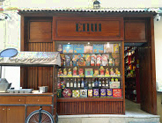 Elegant wood-paneled Ellul—café, wine & spirits store dating to 1837 sits at the corner of our street, and provides what our larder needs in wine, mineral water and strong drink. After shopping, we sit at a shaded street side table outside Ellul to enjoy a cold Cisk, the local lager, and a spritz, and then head around the corner to enter the Co-Cathedral of St John, completed by the Knights in 1577, with an exterior design that was intentionally severe and fortress-like, with twin simple bell towers. But the interior is of the grandest
Elegant wood-paneled Ellul—café, wine & spirits store dating to 1837 sits at the corner of our street, and provides what our larder needs in wine, mineral water and strong drink. After shopping, we sit at a shaded street side table outside Ellul to enjoy a cold Cisk, the local lager, and a spritz, and then head around the corner to enter the Co-Cathedral of St John, completed by the Knights in 1577, with an exterior design that was intentionally severe and fortress-like, with twin simple bell towers. But the interior is of the grandest 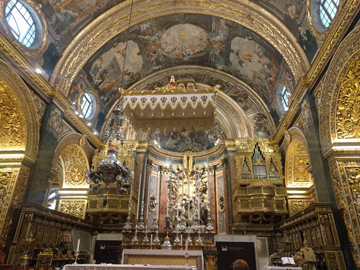 ornamentation of any church or cathedral we’ve ever seen. The great barrel-arched nave and side chapels are covered in gilded carved stone and ornamented with colorful paintings and ceiling frescoes by Mattia Preti. Each of the side chapels is dedicated to one of the eight langues, or regional sectors, of the Knights, such as Italy, France, Prove
ornamentation of any church or cathedral we’ve ever seen. The great barrel-arched nave and side chapels are covered in gilded carved stone and ornamented with colorful paintings and ceiling frescoes by Mattia Preti. Each of the side chapels is dedicated to one of the eight langues, or regional sectors, of the Knights, such as Italy, France, Prove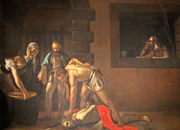 nce, Auvergne and Aragon. The floors are covered with elaborate and colorful inlaid stone sarcophagus tops of important knights. The Oratory contains the largest and only known signed painting by Caravagio—The Beheading of St. John the Baptist, and at its other end his St Jerome—both exemplary of the artist’s chiaroscuoro work with light.
nce, Auvergne and Aragon. The floors are covered with elaborate and colorful inlaid stone sarcophagus tops of important knights. The Oratory contains the largest and only known signed painting by Caravagio—The Beheading of St. John the Baptist, and at its other end his St Jerome—both exemplary of the artist’s chiaroscuoro work with light.
Two blocks away, just off the main square named Misrah San Gorg, sits Grandmaster Palace, built in 1571—seat of administration for Malta for over 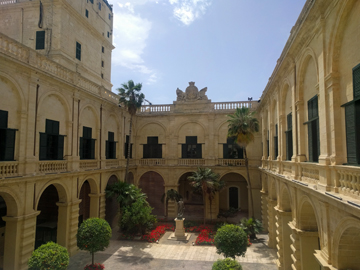 three centuries, and home of each successive Grand Master of the Order. These guys were enormously powerful, and virtually popes in their own right. The entry courtyard is a lush peaceful garden full of trees, palms and flowering plants. Inside are the Armory, a display of more suits of armor, spears, pikes and other arms that one can take in in one visit, and the lushly decorated State Rooms of the palace itself, with frescoed ceilings and intricate inlaid stone floors. Luckily for us, a current exhibition takes up several of the ceremonial rooms: Picasso and Miró: The Flesh & The Spirit—the Picasso portion is the entire 100 image collection of the Vollard Suite, of which we own an impression of image 152, Sculpteur, Modèle, Sculpture et Poisson Rouge which Troy’s parents bought in the 50’s. We’ve never seen the whole suite together before, with the “Sculptor’s Studio” series, “Minotaur” section and the three very different images of Ambroise Vollard, so that’s quite exciting. The 40 Miró oil paintings represent his work from the 60’s and 70’s—we like quite a number but feel that not all are the best examples of his work. But overall the exhibition is a great and lucky find.
three centuries, and home of each successive Grand Master of the Order. These guys were enormously powerful, and virtually popes in their own right. The entry courtyard is a lush peaceful garden full of trees, palms and flowering plants. Inside are the Armory, a display of more suits of armor, spears, pikes and other arms that one can take in in one visit, and the lushly decorated State Rooms of the palace itself, with frescoed ceilings and intricate inlaid stone floors. Luckily for us, a current exhibition takes up several of the ceremonial rooms: Picasso and Miró: The Flesh & The Spirit—the Picasso portion is the entire 100 image collection of the Vollard Suite, of which we own an impression of image 152, Sculpteur, Modèle, Sculpture et Poisson Rouge which Troy’s parents bought in the 50’s. We’ve never seen the whole suite together before, with the “Sculptor’s Studio” series, “Minotaur” section and the three very different images of Ambroise Vollard, so that’s quite exciting. The 40 Miró oil paintings represent his work from the 60’s and 70’s—we like quite a number but feel that not all are the best examples of his work. But overall the exhibition is a great and lucky find.
That evening, after sunset cocktails on our upper terrace, we walk the couple of blocks up Merchant’s Street to a fish restaurant set up under canopies in the middle of the street, La Sfoglia. A large glass display case of fresh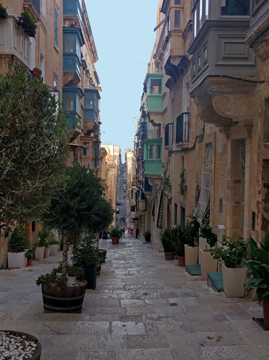 fish contains, grouper, orange rockfish, red and grey bream, shrimp, langostines and some of the largest lobsters we've seen. We consult Jerome, one of the three brothers who own and run the restaurant, and settle on a not-too-large red bream. A frosty bottle of Landini Vermentino from Delicata Vineyards in the middle of the island arrives and is both spicy and floral. We order no starters, as Troy knows from her first night’s dinner here that the fish arrives with an enormous mound of mixed grilled vegetables and potatoes, both roasted and mashed with garlic. In due time the charred grilled bream is presented to us, looking much larger than it did when we picked it from the case (did they ‘upgrade’ us?) and is whisked away for de-boning, and returns with the array of verdure. The bream is perfectly fresh and delicate, and more fish than either of us can eat. As with most such restaurants, fish is priced by the kilo, but this one mysteriously costs exactly €50—and while pricey for one order, given the fact that fish, the wine and one perfect dessert cannolo are the only things on the bill, it’s a pretty reasonable total for dinner for two.
fish contains, grouper, orange rockfish, red and grey bream, shrimp, langostines and some of the largest lobsters we've seen. We consult Jerome, one of the three brothers who own and run the restaurant, and settle on a not-too-large red bream. A frosty bottle of Landini Vermentino from Delicata Vineyards in the middle of the island arrives and is both spicy and floral. We order no starters, as Troy knows from her first night’s dinner here that the fish arrives with an enormous mound of mixed grilled vegetables and potatoes, both roasted and mashed with garlic. In due time the charred grilled bream is presented to us, looking much larger than it did when we picked it from the case (did they ‘upgrade’ us?) and is whisked away for de-boning, and returns with the array of verdure. The bream is perfectly fresh and delicate, and more fish than either of us can eat. As with most such restaurants, fish is priced by the kilo, but this one mysteriously costs exactly €50—and while pricey for one order, given the fact that fish, the wine and one perfect dessert cannolo are the only things on the bill, it’s a pretty reasonable total for dinner for two.
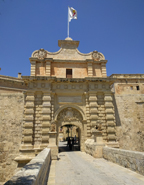 The ancient city of Mdina is a half-hour away by car, which we arrange for the next morning. On the advice of Umberto, we have Rodrigo our driver first take us to the western coast and the remote and stunning Dingli Cliffs,
The ancient city of Mdina is a half-hour away by car, which we arrange for the next morning. On the advice of Umberto, we have Rodrigo our driver first take us to the western coast and the remote and stunning Dingli Cliffs,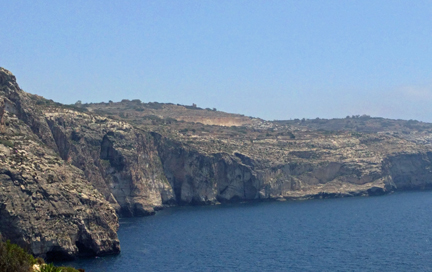 which drop a sheer 250 meters into the blue Mediterranean. Mdina was the original capital of Malta until the middle ages, when coastal Birgu became capital city under the
which drop a sheer 250 meters into the blue Mediterranean. Mdina was the original capital of Malta until the middle ages, when coastal Birgu became capital city under the 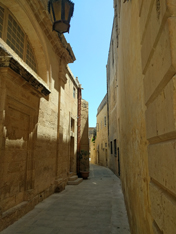 Order of St. John. It’s a perfectly preserved walled town of cobbled streets meandering through buildings of golden stone. It’s an easy half-hour walk from the imposing city gate (which also played a role in early filming of Game of Thrones), past baroque St. Paul’s Cathedral dominating the main square, to Bastion Square at the upper end, with a 180-degree panorama out over the island. Near the square is a house-museum, Palazzo Falson, a 13th century palace belonging originally to a Maltese noble family, which was bought by a Swedish shipping merchant, Olof Gollcher in 1927 and contains his imposing art and antiques collection, spread over three floors
Order of St. John. It’s a perfectly preserved walled town of cobbled streets meandering through buildings of golden stone. It’s an easy half-hour walk from the imposing city gate (which also played a role in early filming of Game of Thrones), past baroque St. Paul’s Cathedral dominating the main square, to Bastion Square at the upper end, with a 180-degree panorama out over the island. Near the square is a house-museum, Palazzo Falson, a 13th century palace belonging originally to a Maltese noble family, which was bought by a Swedish shipping merchant, Olof Gollcher in 1927 and contains his imposing art and antiques collection, spread over three floors 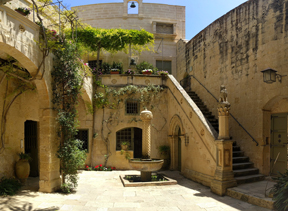 around a fountained courtyard. Down a narrow alley, sited in part literally on the wide walls of the city is La Fontanella restaurant—very popular and busy—where we find a small table tucked at the edge of the wall, with a breeze and a view. We order traditional Maltese Ftira—the local flatbread, somewhat ciabbata-like, smeared with olive oil and tomato paste, and filled with tuna, egg, olives, capers and a
around a fountained courtyard. Down a narrow alley, sited in part literally on the wide walls of the city is La Fontanella restaurant—very popular and busy—where we find a small table tucked at the edge of the wall, with a breeze and a view. We order traditional Maltese Ftira—the local flatbread, somewhat ciabbata-like, smeared with olive oil and tomato paste, and filled with tuna, egg, olives, capers and a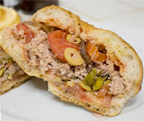 local sheep cheese called Ġbejna. Along with a cold Cisk a perfect lunch—with an unbeatable vista.
local sheep cheese called Ġbejna. Along with a cold Cisk a perfect lunch—with an unbeatable vista.
Returning to Valletta, we meander through the lush Upper 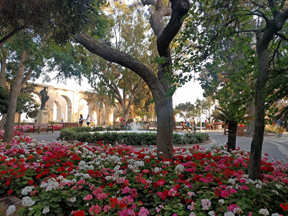 Barrakka Gardens, which offer sweeping views of Grand Harbor, St Angelos Fort and the Three Cities. A level below the Gardens is a lower terrace containing a rank of historic 19th century canons known as the British Saluting Battery—the canons are fired in a noon-day gun ceremony. The NATO Tunnels and War Rooms are located as a museum under the gardens. Two blocks away, just inside the Malta Gate a striking geometric modern façade designed by Renzo Piano houses the Malta Parliament Buidling.
Barrakka Gardens, which offer sweeping views of Grand Harbor, St Angelos Fort and the Three Cities. A level below the Gardens is a lower terrace containing a rank of historic 19th century canons known as the British Saluting Battery—the canons are fired in a noon-day gun ceremony. The NATO Tunnels and War Rooms are located as a museum under the gardens. Two blocks away, just inside the Malta Gate a striking geometric modern façade designed by Renzo Piano houses the Malta Parliament Buidling.
At the edge of Barrakka Gardens are dual glassed exterior elevator that descends the four stories or so from Valletta city level to the waterfront. The Three Cities ferry departs from the quayside and crosses Grand Harbor to Cospicua. We intend to rent a “rolling robot”—an electric cart with GPS and audioguide—from Rolling Geeks along the dock, but find they are fully booked. As a consolation guide, we join the Fun Train which winds up the hill, through Vittoriosa, past the Inquisitor’s Palace and Fort Saint Angelo, around Kalkara harbor and beach and down the narrow winding streets of Co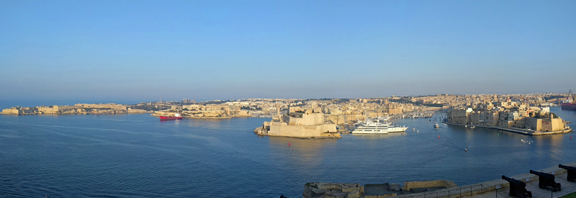 spicua. Also called Birgu, Vittoriosa was the first coastal capital of Malta when the Knights took over, from 1530 to 1571, after which Valletta became the capital. Everyone from the Phoenicians, Greeks, Romans and Arabs on have been involved in evolution of the city. There is another War Museum in Vittoriosa as well as a Maritime Museum set in an old Naval bakery building along the promenade. We have a simple lunch of Caprese salad and cold grilled shrimp with a glass of chilled rose at La Marina Trattoria, before re-crossing Grand Harbor on the ferry.
spicua. Also called Birgu, Vittoriosa was the first coastal capital of Malta when the Knights took over, from 1530 to 1571, after which Valletta became the capital. Everyone from the Phoenicians, Greeks, Romans and Arabs on have been involved in evolution of the city. There is another War Museum in Vittoriosa as well as a Maritime Museum set in an old Naval bakery building along the promenade. We have a simple lunch of Caprese salad and cold grilled shrimp with a glass of chilled rose at La Marina Trattoria, before re-crossing Grand Harbor on the ferry.
The Maltese love fireworks, and there are the sights and sounds of rockets and bombs all over the island every night. After a terrace picnic, we settle in for a final nightcap in the silken air to the sounds of festivities, and the deep gong of 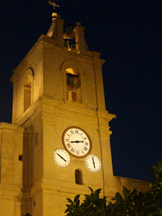 midnight struck in the bell tower of nearby St. John's Cathedral seems to wish us farewell.
midnight struck in the bell tower of nearby St. John's Cathedral seems to wish us farewell.